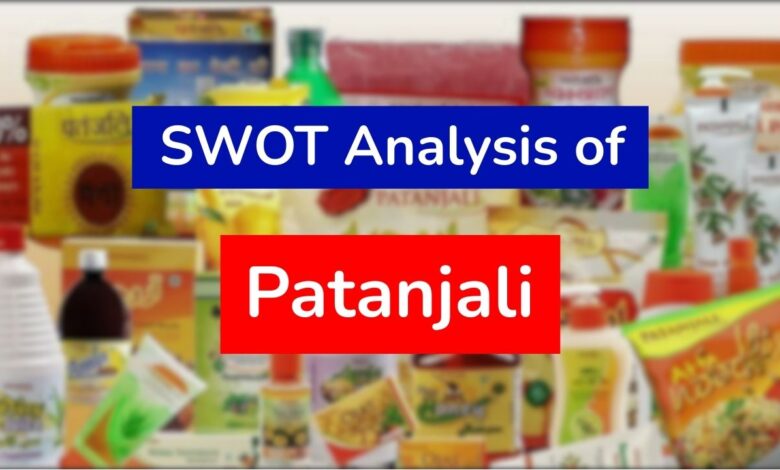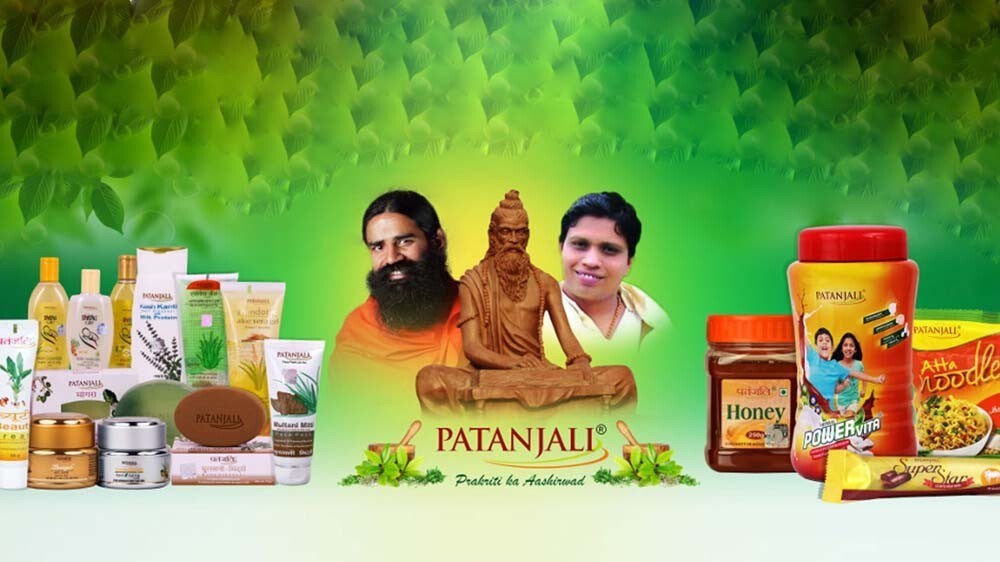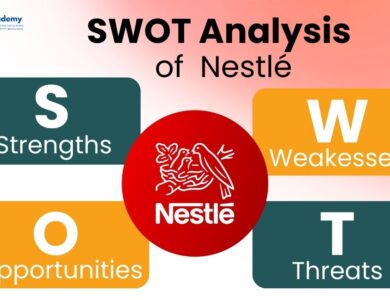Complete SWOT Analysis of Patanjali – India’s Leading Ayurvedic Brand

Patanjali Ayurved, founded by Baba Ramdev and Acharya Balkrishna, has become one of India’s most prominent and rapidly growing brands in the FMCG sector.
Since its inception in 2006, Patanjali has revolutionized the Indian market by offering a wide range of Ayurvedic products, including healthcare, personal care, and food items.
Patanjali’s growth can be attributed to its focus on natural, herbal ingredients and its commitment to offering affordable alternatives to traditional consumer goods.
Patanjali has made a significant impact on the Indian FMCG market, positioning itself as the leading Ayurvedic brand in the country. From Patanjali Ghee and toothpaste to Chyawanprash and honey, its products are staples in millions of Indian households.
The brand has also successfully expanded into international markets, capitalizing on the growing global demand for natural and organic products.
In this article, we will explore Patanjali’s Strengths, Weaknesses, Opportunities, and Threats (SWOT analysis). Understanding these elements will provide valuable insights into how Patanjali continues to dominate the Ayurvedic market while facing external challenges in a highly competitive FMCG sector.
This analysis also sheds light on Patanjali’s strategic direction and its ability to leverage its traditional Ayurvedic roots to meet the needs of modern consumers.

Learn AI & Digital Marketing,
Pay Fees After Placement
- ✅ Minimal Admission Fees
- ✅ No Loan or Income Sharing Agreement
- ✅ 100% Placement Support
- ✅ ISO & Govt Registered Certificate
- ✅ Practical 3+1 Months Duration
Get a free counseling call. We’ll guide you through learning, certification, and job placement.
Request a Free Call Back
Takes less than a minute.
Company Overview – About Patanjali
Patanjali Ayurved, founded in 2006 by Baba Ramdev and Acharya Balkrishna, has quickly grown to become one of the largest Indian FMCG companies focused on Ayurvedic products.
Headquartered in Haridwar, Patanjali’s mission is to promote health and well-being by providing consumers with high-quality, natural products that are free from harmful chemicals.
The company has become a leader in India’s health and wellness industry, offering products across various categories including personal care, healthcare, food, and beverages.
Patanjali has made a significant mark in the consumer goods market with its range of affordable and natural products. Its offerings include well-known products like Patanjali Ghee, Ayurvedic toothpaste, Chyawanprash, honey, oils, and medicinal herbs.
These products have made their way into millions of Indian homes and have helped the brand build a strong customer base among consumers seeking natural alternatives to conventional FMCG products.
Patanjali’s growth has been bolstered by the massive popularity of Baba Ramdev, whose strong public persona and association with yoga and traditional Ayurvedic practices have greatly contributed to the brand’s credibility.
Over the years, Patanjali has expanded its reach through its own retail outlets as well as partnerships with supermarkets, online platforms, and local stores, making its products easily accessible across India and beyond.
In addition to its FMCG products, Patanjali has ventured into international markets, exporting its products to countries with a growing demand for natural and organic goods.
With its focus on traditional Ayurvedic formulations and its commitment to affordability, Patanjali has positioned itself as a major player in the Indian health and wellness market.
What is SWOT Analysis?
A SWOT analysis is a strategic tool used by companies to evaluate their current position in the market by analyzing Strengths, Weaknesses, Opportunities, and Threats. It helps businesses understand both internal and external factors that can influence their success.
The insights derived from a SWOT analysis allow companies to capitalize on their strengths, address weaknesses, seize opportunities, and prepare for potential threats.
- S – Strengths: These are the internal factors that give the company a competitive advantage in the market. Strengths could include strong brand equity, product innovation, customer loyalty, or cost efficiencies.
- W – Weaknesses: These are internal factors or limitations that could hinder growth or reduce efficiency. Weaknesses could include high operating costs, limited product range, or supply chain inefficiencies.
- O – Opportunities: These are external factors or trends in the market that the company can leverage to expand or improve. Opportunities could include emerging markets, new consumer trends, or technological advancements.
- T – Threats: These are external factors that could negatively impact the company’s success. Threats might include competition, economic downturns, regulatory changes, or market saturation.
For Patanjali, a SWOT analysis will help us understand how the company’s traditional Ayurvedic products and brand values contribute to its success and how it can navigate the challenges in an increasingly competitive FMCG market.
By evaluating Patanjali’s internal capabilities and the external market dynamics, we can gain insights into its future growth potential and the risks it faces in both domestic and international markets.
Patanjali’s Strengths
Patanjali’s rapid growth in the Indian FMCG market can be attributed to several key strengths that have helped the brand differentiate itself from competitors and maintain a strong market presence.
🌱 1. Strong Brand Identity and Trust
Patanjali’s brand identity is built around Ayurveda, a traditional system of medicine that resonates with millions of Indian consumers.
The brand’s association with Baba Ramdev, a highly respected figure in India, has significantly bolstered its credibility.
His public persona, rooted in promoting yoga, natural health, and well-being, has played a crucial role in establishing Patanjali as a trustworthy brand in the healthcare and wellness space.
This brand trust has enabled Patanjali to build a loyal customer base.
🏪 2. Extensive Product Portfolio
Patanjali offers a diverse range of products, including personal care, healthcare, food, and beverages.
The company’s products, such as Patanjali Ghee, Chyawanprash, Toothpaste, and Honey, cater to a broad spectrum of consumer needs.
By offering a variety of affordable Ayurvedic products, Patanjali appeals to different customer segments, including those seeking natural alternatives to chemical-based FMCG products.
💰 3. Competitive Pricing Strategy
One of Patanjali’s standout strengths is its affordable pricing. The company offers high-quality Ayurvedic products at competitive prices, making them accessible to a wide range of consumers.
This cost-effective approach has allowed Patanjali to attract price-sensitive customers while competing with established FMCG giants.
The affordability of its products is particularly appealing to the growing middle-class population in India, who are increasingly opting for health-conscious products.
🛒 4. Strong Distribution Network
Patanjali has developed a robust distribution network that allows it to reach millions of customers across India.
With over 5,000 stores across the country and a presence in supermarkets and online platforms, Patanjali products are easily accessible to consumers.
The company has also made its products available in local kirana stores, which has expanded its reach to rural and semi-urban areas, where demand for natural products is rising.
🌍 5. Rising Consumer Consciousness for Natural Products
There is an increasing consumer preference for natural and organic products, driven by a growing awareness of the harmful effects of chemicals in food and personal care products.
This shift in consumer behavior aligns perfectly with Patanjali’s focus on Ayurvedic and herbal products. As consumers become more health-conscious, Patanjali is well-positioned to capitalize on this trend, offering a wide range of natural solutions for everyday needs.
💪 6. Strong Marketing and Publicity
Patanjali has invested heavily in advertising and public relations to build its brand presence. Baba Ramdev’s television appearances, yoga camps, and public endorsements have contributed to Patanjali’s high visibility.
The brand’s marketing campaigns often emphasize its traditional and Indian heritage, appealing to nationalistic sentiments and reinforcing its identity as a homegrown brand that offers a healthier, more natural alternative to multinational competitors.
These strengths have played a pivotal role in Patanjali’s rise to prominence in the FMCG market. The brand’s focus on Ayurveda, affordable pricing, and wide distribution has allowed it to carve out a unique position in a competitive industry.
Patanjali’s Weaknesses
While Patanjali has enjoyed rapid growth, there are several weaknesses that could hinder its long-term success. These internal challenges must be addressed to ensure the brand’s continued dominance in the market.
🚧 1. Overdependence on Baba Ramdev’s Persona
One of Patanjali’s major strengths is its association with Baba Ramdev, a highly influential public figure. However, this overreliance on Baba Ramdev’s persona could also pose a risk in the long term.
If his image were to suffer due to controversies or shifting consumer perceptions, it could negatively affect the brand. Additionally, consumers may begin to see Patanjali as a one-man brand, limiting its appeal beyond Baba Ramdev’s influence.
⚖️ 2. Limited Innovation and Modernization
While Patanjali has successfully tapped into the demand for natural products, its innovation in terms of product development and packaging has been slower compared to its competitors.
The company’s products are largely based on traditional Ayurvedic formulations, which may not always appeal to younger consumers looking for modern, innovative solutions.
Compared to other FMCG brands, Patanjali has been less agile in embracing trends like personalization, luxury branding, or advanced packaging.
📦 3. Supply Chain and Quality Control Issues
As Patanjali scales its operations, it faces challenges in maintaining consistent quality control across its wide range of products.
Instances of product recalls and inconsistent quality have raised concerns about Patanjali’s ability to handle its growing operations effectively.
The brand’s focus on natural ingredients makes it more susceptible to supply chain disruptions and quality issues, especially with the rapid increase in demand for Ayurvedic products.
🌍 4. Limited Global Expansion
Despite its success in the Indian market, Patanjali’s international presence remains limited.
While the company has ventured into some international markets, such as the Middle East and Nepal, its global reach is still far behind competitors like Hindustan Unilever and Procter & Gamble.
For Patanjali to truly become a global FMCG player, it needs to significantly improve its global distribution network and adapt its products to meet the needs of diverse international markets.
🏪 5. Challenges with Distribution Channels
Although Patanjali has established a strong retail network, including over 5,000 stores across India, it still faces challenges related to distribution efficiency.
The company’s exclusive focus on traditional retail outlets and limited e-commerce presence means it may miss out on the growing trend of online shopping, especially among younger, digital-savvy consumers. Expanding and optimizing its digital sales channels could help Patanjali capture a larger share of the market.
💼 6. Regulatory Scrutiny
As Patanjali grows, it faces increasing regulatory scrutiny, particularly concerning the claims made about the health benefits of its products. The brand’s Ayurvedic formulations may be subjected to stricter government regulations, especially as healthcare claims in the FMCG space become more regulated.
Any regulatory challenges could limit Patanjali’s ability to market its products or even result in fines or legal issues.
These weaknesses highlight the areas where Patanjali must improve to sustain long-term growth and maintain its competitive edge. Addressing these internal challenges will be crucial for the brand to stay relevant and continue to lead in the Ayurvedic and FMCG markets.
Patanjali’s Opportunities
Patanjali is well-positioned to capitalize on several growth opportunities that could help it expand its market reach, diversify its product offerings, and strengthen its competitive position in the FMCG sector.
By seizing these opportunities, Patanjali can continue to dominate the Ayurvedic and natural products market both in India and internationally.
🌍 1. Global Expansion and International Markets
Patanjali has a significant opportunity to expand its global presence. With growing consumer demand for natural, organic, and Ayurvedic products in markets like North America, Europe, and the Middle East, Patanjali can tap into international markets where consumers are increasingly seeking health-conscious alternatives.
By adapting its products to local preferences and regulations, Patanjali can position itself as a global leader in the health and wellness industry.
🏪 2. E-commerce and Digital Sales Growth
The rise of online shopping presents a huge opportunity for Patanjali to expand its e-commerce presence. By increasing its digital footprint, Patanjali can attract younger, more tech-savvy consumers who prefer to shop online.
Optimizing its website, partnering with major e-commerce platforms like Amazon and Flipkart, and launching targeted digital marketing campaigns will allow Patanjali to capture the growing online market for Ayurvedic and wellness products.
🧑⚕️ 3. Growing Consumer Interest in Health and Wellness
Consumers are becoming increasingly conscious of their health and well-being, and there is a growing preference for natural, organic, and chemical-free products.
Patanjali’s focus on Ayurvedic ingredients positions it well to capitalize on the health and wellness trend. The brand can further expand its product line to include nutritional supplements, herbal teas, organic snacks, and functional foods that cater to health-conscious consumers.
💡 4. Innovation in Product Development
Although Patanjali has a strong product offering, it can further innovate by expanding its product range to include new categories such as plant-based foods, sustainable personal care products, and eco-friendly packaging.
The company can explore newer segments like fitness supplements, natural cosmetics, and holistic wellness products. By leveraging trends like veganism, plant-based diets, and clean beauty, Patanjali can reach a broader, health-focused audience.
🏥 5. Strategic Partnerships with Global Retailers
Patanjali can explore strategic partnerships with global retailers and distributors to expand its presence in international markets.
Collaborating with established retail chains like Walmart, Carrefour, and Target could enable Patanjali to quickly scale its operations outside of India. By partnering with large retailers, Patanjali can leverage their distribution networks and customer bases to enter new markets more effectively.
🌱 6. Increased Focus on Sustainability and Ethical Sourcing
As sustainability becomes a key concern for consumers, Patanjali can seize the opportunity to position itself as a sustainable brand.
By focusing on eco-friendly packaging, responsible sourcing, and ethical manufacturing, Patanjali can appeal to eco-conscious consumers who prefer products from brands committed to environmental responsibility. Sustainability can be a key differentiator for Patanjali, setting it apart from other FMCG giants and strengthening its brand image.
🛒 7. Expansion into Functional Foods and Nutraceuticals
There is a growing demand for functional foods and nutraceuticals that promote health beyond basic nutrition. Patanjali can diversify its product range by introducing herbal-based supplements, digestive aids, and energy-boosting products.
With its focus on natural ingredients, Patanjali can tap into the rising popularity of preventive healthcare and holistic wellness.
These opportunities offer Patanjali a range of avenues to grow its market share, expand globally, and stay ahead of evolving consumer preferences. By embracing innovation, digital transformation, and sustainability, Patanjali can continue to lead in the health and wellness sector, both in India and internationally.
Patanjali’s Threats
Despite its success, Patanjali faces several external threats that could challenge its growth and profitability. These threats come from factors such as intense competition, regulatory changes, and shifts in consumer behavior. Addressing these threats will be essential for Patanjali to maintain its leadership in the Ayurvedic and FMCG markets.
⚔️ 1. Intense Competition in the FMCG Sector
Patanjali operates in a highly competitive FMCG sector, with strong competition from both global FMCG giants like Hindustan Unilever, Procter & Gamble, and ITC, and local Ayurvedic brands such as Dabur and Baidyanath.
These competitors have larger marketing budgets, established brand recognition, and extensive distribution networks, which pose significant challenges to Patanjali’s market share. Additionally, the rise of new-age wellness startups offering organic and natural products could further intensify the competition.
🏛️ 2. Regulatory and Compliance Challenges
As Patanjali operates in the healthcare and food industries, it is subject to increasing government scrutiny and regulations. In particular, the company must comply with stringent food safety regulations and claims around health benefits for its products.
Ayurvedic products, in particular, face regulatory challenges regarding the validation of health claims. Any changes in regulations related to ingredient sourcing, product labeling, or advertising guidelines could affect Patanjali’s ability to market its products and impact its revenue streams.
📉 3. Price Wars and Margin Erosion
Patanjali’s affordable pricing strategy has been one of its main strengths, but it also exposes the company to risks associated with price wars. As competitors like Dabur and Hindustan Unilever introduce their own natural or Ayurvedic product lines, Patanjali may face downward pressure on prices.
This could lead to margin erosion, especially if Patanjali is forced to lower its prices to compete or offer more discounts. Sustaining its profit margins without sacrificing quality will be a key challenge.
🏪 4. Supply Chain Vulnerabilities
Patanjali’s supply chain is largely dependent on the availability of raw materials for its Ayurvedic products, many of which come from traditional sources.
Supply chain disruptions due to factors like climatic conditions, labor shortages, or logistical inefficiencies could impact Patanjali’s ability to maintain consistent product availability. Additionally, sourcing herbal ingredients from diverse suppliers across India can pose risks in terms of quality control, which can affect brand reputation.
🧑⚖️ 5. Brand Perception and Controversies
While Patanjali has gained substantial brand recognition, it is not immune to public relations issues or controversies. The company’s association with Baba Ramdev could also bring reputational risks, as his image and public statements sometimes lead to controversies.
Any negative media coverage or public backlash could affect the company’s brand trust and customer loyalty. Moreover, any discrepancies or quality-related issues in Patanjali’s products could significantly damage its brand reputation.
📊 6. Shifting Consumer Preferences
Consumer preferences are continually evolving, and younger generations are becoming more health-conscious and digitally savvy.
If Patanjali doesn’t adapt its marketing strategies, product offerings, or packaging to appeal to younger, health-conscious consumers, it may risk losing market share to competitors that are better at targeting this demographic.
Trends such as plant-based diets, veganism, and clean beauty may demand new products or adjustments to existing formulations, requiring Patanjali to continuously innovate to stay relevant.
🌍 7. Economic Uncertainty and Spending Shifts
Patanjali, like many other FMCG brands, is vulnerable to economic downturns or shifts in consumer spending behavior.
During economic slowdowns, consumers tend to cut back on non-essential purchases, which could affect sales of Patanjali’s premium products or wellness-focused offerings. Economic factors such as inflation, rising fuel prices, or reduced consumer confidence can also lead to increased operational costs and reduced demand for products.
These threats highlight the external challenges Patanjali faces as it navigates the FMCG and healthcare markets. To remain competitive, the company will need to adapt to changing consumer preferences, manage regulatory hurdles, and address the growing competition in the sector.
Patanjali’s Strategy Moving Forward
Patanjali has established itself as a leader in India’s Ayurvedic and FMCG market, but to sustain growth and maintain market dominance, the company must continue to evolve. Here’s how Patanjali can address its weaknesses, leverage opportunities, and navigate potential threats to achieve long-term success.
🌍 1. Global Expansion and Strengthening International Presence
While Patanjali has made some strides in international markets, its global presence remains limited compared to larger FMCG players.
By focusing on expanding into international markets—especially in regions with growing demand for natural and Ayurvedic products, such as North America, Europe, and the Middle East—Patanjali can tap into new revenue streams.
The company needs to localize its product offerings, understand local consumer preferences, and comply with international regulations to ensure success in global markets.
💡 2. Innovation in Product Development
To appeal to younger, more health-conscious consumers, Patanjali must focus on product innovation. This could include launching new product lines in trending areas such as plant-based foods, functional wellness products, and sustainable beauty products.
By keeping up with changing consumer needs and global wellness trends, Patanjali can maintain its relevance in an increasingly competitive market. Additionally, embracing modern packaging and branding strategies that emphasize sustainability and eco-consciousness will help the brand attract the younger demographic.
🛒 3. Strengthening E-commerce and Digital Marketing
Patanjali has the opportunity to further strengthen its digital presence by investing in e-commerce platforms and digital marketing strategies.
The company should focus on enhancing its online sales channels to cater to the growing number of digital-first consumers, especially in urban areas.
This includes optimizing its website, partnering with major e-commerce players like Amazon and Flipkart, and using social media to build brand awareness and engage with younger, tech-savvy audiences. Personalized marketing campaigns and targeted promotions can help boost online sales.
🧑⚕️ 4. Expanding Product Portfolio with Nutraceuticals and Functional Foods
With the growing interest in preventive healthcare and functional foods, Patanjali can expand its offerings to include more nutraceuticals, herbal supplements, and organic food items. This will cater to the increasing demand for health-enhancing products and help position Patanjali as a holistic wellness brand.
By offering natural alternatives to traditional supplements and functional foods, Patanjali can tap into a broader market segment looking for alternative health solutions.
🏪 5. Improving Retail and Distribution Efficiency
While Patanjali has a strong retail presence, it can further improve its distribution network by enhancing logistics efficiency and exploring omnichannel retail strategies.
Leveraging modern distribution techniques, such as warehouse automation, inventory management systems, and direct-to-consumer models, will help Patanjali meet growing demand while maintaining product availability. Investing in mobile apps or online platforms for direct sales could also streamline consumer purchases and improve retail performance.
🌱 6. Focus on Sustainability and Ethical Practices
Consumers today are increasingly prioritizing sustainability, and brands that embrace eco-friendly practices are likely to gain customer loyalty. Patanjali can enhance its sustainability efforts by focusing on eco-friendly packaging, green manufacturing processes, and ethical sourcing for its ingredients.
By making its products more sustainable and aligning with global environmental standards, Patanjali can appeal to eco-conscious consumers and strengthen its brand image as a responsible, ethical company.
📈 7. Managing Competition and Price Wars
Patanjali must continue to focus on maintaining its pricing advantage while ensuring that its profit margins do not suffer due to price wars.
By differentiating itself through superior quality, brand trust, and unique Ayurvedic formulations, Patanjali can continue to compete effectively without having to engage in unsustainable discounting.
Strategic brand positioning around health and wellness rather than just price will help Patanjali build a loyal customer base that values the quality and benefits of its products.
Conclusion & Final Thoughts
Patanjali has swiftly risen to become a dominant player in India’s Ayurvedic and FMCG markets, driven by its strong brand identity, affordable pricing, and extensive product range.
The brand’s deep roots in traditional Ayurvedic practices and Baba Ramdev’s influence have helped Patanjali build significant brand trust and capture the attention of millions of Indian consumers seeking natural and chemical-free products.
However, Patanjali faces challenges, including overdependence on Baba Ramdev’s persona, limited global expansion, and the rising competition from both traditional FMCG giants and newer entrants.
To continue its success, Patanjali must innovate and adapt, focusing on global expansion, digital marketing, and sustainability. Additionally, addressing supply chain issues and regulatory scrutiny will be crucial for maintaining its reputation and ensuring continued growth.
Looking ahead, Patanjali’s opportunities—including global market expansion, product diversification into nutraceuticals and wellness products, and stronger e-commerce strategies—are significant. By capitalizing on these opportunities and addressing its internal weaknesses and external threats, Patanjali can remain a leading brand in the Indian and global health and wellness space, maintaining its competitive edge in an ever-evolving FMCG market.
What do you think about Patanjali’s future?
💬 Can Patanjali continue to dominate the FMCG sector, or will competition and market challenges limit its growth? Share your thoughts below!





